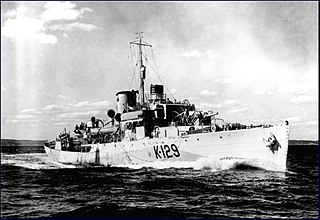
HMCS Pictou was a Royal Canadian Navy Flower-class corvette which took part in convoy escort duties during the Second World War. She fought mainly in the Battle of the Atlantic. She was named for Pictou, Nova Scotia.

HMCS Sackville is a Flower-class corvette that served in the Royal Canadian Navy and later served as a civilian research vessel. She is now a museum ship located in Halifax, Nova Scotia, and the last surviving Flower-class corvette.

HMCS Rimouski was a Royal Canadian Navy Flower-class corvette which took part in convoy escort duties during the Second World War. She fought primarily in the Battle of the Atlantic. She was named after Rimouski, Quebec.

Mid-Ocean Escort Force (MOEF) referred to the organisation of anti-submarine escorts for World War II trade convoys between Canada and Newfoundland, and the British Isles. The allocation of United States, British and Canadian escorts to these convoys reflected preferences of the United States upon United States' declaration of war and the organisation persisted through the winter of 1942–43 despite withdrawal of United States ships from the escort groups. By the summer of 1943, United States Atlantic escorts were focused on the faster CU convoys and the UG convoys between Chesapeake Bay and the Mediterranean Sea; and only British and Canadian escorts remained on the HX, SC and ON convoys.

Western Local Escort Force (WLEF) referred to the organization of anti-submarine escorts for World War II trade convoys from North American port cities to the Western Ocean Meeting Point near Newfoundland where ships of the Mid-Ocean Escort Force (MOEF) assumed responsibility for safely delivering the convoys to the British Isles.

HMCS Mayflower was a Flower-class corvette that served mainly in the Royal Canadian Navy during the Second World War but began her service with the Royal Navy. She saw action primarily in the Battle of the Atlantic as an ocean escort. She was named after the flowering plant Maianthemum canadense.

HMCS Trillium was a Flower-class corvette that served in the Royal Canadian Navy during the Second World War. She served mainly as a convoy escort in the Battle of the Atlantic. She was one of ten corvettes loaned to the Canadian navy by the Royal Navy and the only one which remained an ocean escort throughout the war. She was named after the flowering plant genus Trillium, which includes wakerobin, tri flower, and birthroot.

HMCS Rosthern was a Flower-class corvette that served in the Royal Canadian Navy during the Second World War. She served primarily in the Battle of the Atlantic as a convoy escort. She is named for Rosthern, Saskatchewan.

HMS Dianthus was a Flower-class corvette of the Royal Navy. She was launched on 9 July 1940 from the Leith Docks on the Firth of Forth and named after the genus of flowering plants including Carnation, Pink, and Sweet William. The ship escorted trade convoys between Newfoundland and the Western Approaches through the Battle of the Atlantic wolf pack attacks of the winter of 1942–43.

HMCS Wetaskiwin was a Flower-class corvette of the Royal Canadian Navy that served during the Second World War. She served primarily as a convoy escort in the Battle of the Atlantic. She was named after the city of Wetaskiwin, Alberta. Wetaskiwin was the first Pacific coast built corvette to enter service with the Royal Canadian Navy.

HMCS Galt was a Flower-class corvette of the Royal Canadian Navy that served during the Second World War. She saw action primarily in the Battle of the Atlantic. She was named after the city of Galt, Ontario.

HMCS Agassiz was a Flower-class corvette of the Royal Canadian Navy. Named after the community of Agassiz, British Columbia, the ship was constructed by Burrard Dry Dock Co. Ltd. in North Vancouver, British Columbia and was launched on 15 August 1940. The corvette was commissioned on 23 January 1941 in Vancouver, British Columbia. The Flower class were initially designed for coastal service during the Second World War, but due to the demands of the Battle of the Atlantic, Agassiz was used primarily as an ocean escort for convoys crossing the Atlantic Ocean in engagements with German submarines. Following the war, the corvette was sold for scrap.

HMCS Eyebright was a Flower-class corvette that served mainly with the Royal Canadian Navy during the Second World War in the Battle of the Atlantic. She was named after the medicinal flowering plant genus Euphrasia.

HMCS Battleford was a Flower-class corvette of the Royal Canadian Navy launched on 15 April 1940 and commissioned on 31 July 1941 during the Second World War. The corvette served primarily in the Battle of the Atlantic, escorting convoys of merchant ships. After the war she was sold to the Venezuelan Navy and renamed Libertad. Libertad was wrecked on 12 April 1949.

HMCS Chilliwack was a Flower-class corvette who served with the Royal Canadian Navy during the Second World War. She saw action primarily in the Battle of the Atlantic as a convoy escort. She was named for Chilliwack, British Columbia.

HMCS Napanee was a Flower-class corvette of the Royal Canadian Navy during the Second World War. She saw service primarily in the Battle of the Atlantic as a convoy escort. She is named after Napanee, Ontario.

HMCS Shediac was a Flower-class corvette of the Royal Canadian Navy during the Second World War. She served primarily in the Battle of the Atlantic as a convoy escort. She was named after the town of Shediac, New Brunswick.

HMCS Sherbrooke was a Flower-class corvette that served with the Royal Canadian Navy during the Second World War. She served primarily in the Battle of the Atlantic as an ocean escort. She is named for Sherbrooke, Quebec.

HMCS St. Lambert was a modified Flower-class corvette that served with the Royal Canadian Navy during the Second World War. She fought primarily in the Battle of the Atlantic as a convoy escort. She was named for Saint-Lambert, Quebec.

HMS Alisma was a Flower-class corvette that served in the Royal Navy.


















